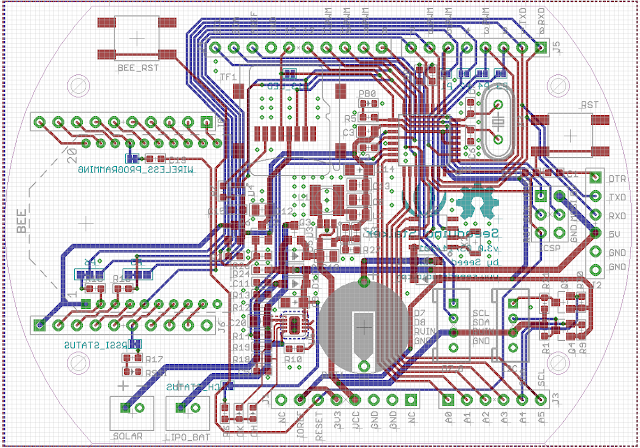Knowing what I want, lacking confidence to spot a defect, imagine the frustration in discovering the underlying component I was using to prototype has a major design flaw. Seeed Studio offers a low power board with great components for a battery operated design. It uses the lower power ATMega328p, has an efficient switching regulator, built-in support for lipo battery and solar charging; delicious. It also has an XBee socket. It was the ideal board for my battery operated pulse counter prototype.
Perfect until the wheels feel off. For whatever the reason, Seeed decided to create an out-of-the box conflict between the serial interface and the xbee; they both used pins 0 and 1. Out of the box you cannot access your xbee socket and then see what it is doing via the serial monitor. Clearly Seeed considered this and included "pads" on the back of the board to allow for pin 2 and pin 3 (td/rx) on the xbee socket to remap to P5 and P6 on the mega; great. Only problem; doesn't work. Here is where the lack of confidence comes into play. Seeed introduced a hidden variable into my project, challenging me.
The air was thick around here. My boxer decided to spend more and more time on the driveway while I yelled and cursed at this board; "why the F isn't this working!!!" Seeed is in absolute denial, even though this was revealed months ago on their own forum, where they admit to the defect.
Here is the thing; there is an obscure design defect on the Stalker V3. The P5 pad does not go anywhere, Seeed knows about and they are engaging cavete emptor; let the buyer beware; not cool at all. The problem is I like this board. They acknowledged the defect months ago on their forum, yet they have not updated their docs, nor stated how they plan to resolve this problem. This does help explain when Seeed was blowing these boards out at 80% off a month ago; suckers.
If you are curious, look at the lower left corner of the V3 schematic by the R16 resistor
See how the P5 does not attach to the right of the R16 resisitor on the P5 Pad but goes direct to P0 on the mega? It should look like P6 to the R15 resistor. The reason this is a such a big problem is the xbee and the uarts both map to p0 / p1 and conflict; you cannot have the uarts -and- and xbee at the same time without remapping the xbee. This is why they put in the p5 and p6 pads to allow for both uarts and xbee. Problem is, they didn't catch their P5 mistake and went into to production with the defect. There is second defect as well, which only adds insult to injury; the through-hole on the xbee does not goto P2 nor P3. P9 tests ok, but P2 and P3, that path is missing.
This is the only way I could get this board to work properly.
Elegant, don't you think?
SEEED, it is time to recall this board and make this right. At the very least, disclose this defect.


Thanks, just found this. I was aware of the defect, but you do a much better job of explaining it that Seeed. FWIW, the new v3.1 board fixes the problem. Of course, the first one I got has a totally different problem - missing SMT transistor in the power supply. Nice! The weird thing is the 328P is supplied, but not the pin header, so you can load sketches, etc., but the board is useless. No XBee power, either. Replacement on order, but I have to say Seeed is a mixed bag at best. Thanks again.
ReplyDelete